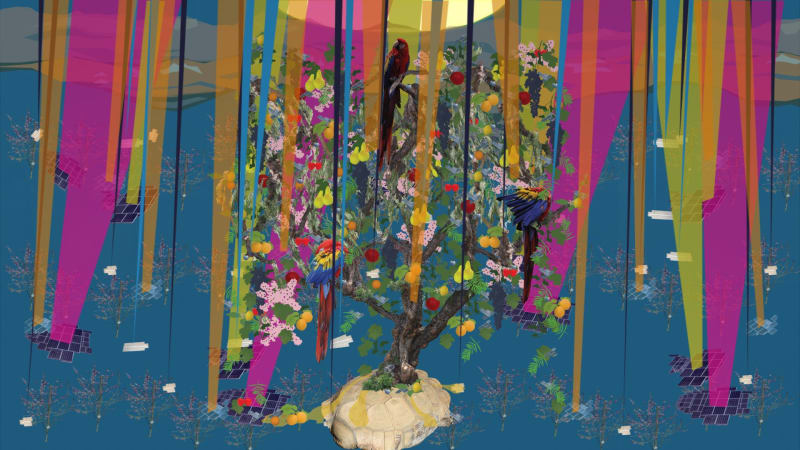Aaron Wilder
Jul 31, 2022
In last month's column, I focused on artist Wayne Hodge. This month, I would like to continue celebrating Future Shock: (Re)Visions of Tomorrow, a large exhibition inhabiting three galleries at the Roswell Museum co-curated by our Executive Director Caroline Brooks and myself. This month, I would like to focus on another participating artist: Ranu Mukherjee.
I first met Mukherjee in the San Francisco Bay Area in 2019 toward the end of my tenure as curator and interim director of the Natalie and James Thompson Art Gallery at San José State University. Mukherjee was the last participant in our fall 2019 weekly lecture series. Her presentation was entitled A Completely Matter of Fact Acceptance of the Agency of Non-Humans. I have kept in touch with Mukherjee since then and was thrilled when she accepted our invitation to participate in Future Shock.
The work of interdisciplinary artist Mukherjee is intensely layered. Resolutely combining mediums into hybrid forms, she employs installation, painting, and video. Inspired by histories of Black feminist science fiction, collage, and Indian mythological prints from the 19th and 20th centuries, Mukherjee's projects consider the possibility of multiple futures.
Guided by forces of diaspora and migration, ecology, non-human agency, and transnational feminisms as well as the experience of motherhood, she explores the possibility of constructing new imaginative faculties from experiences of disruption and desire. The realm of speculative fiction has proved particularly generative for Mukherjee's recent works charting a course from historic and present crises to possible futures of healing.
With a Bachelor's of Fine Art from the Massachusetts College of Art in Boston and a master's degree from the Royal College of Art in London, Mukherjee is based in the San Francisco area where she teaches in the MFA program at California College of the Arts.
Two video works by Mukherjee are included in the exhibition Future Shock: (Re)Visions of Tomorrow. Her nine channel video installation The Dead and the Wild is installed in an intervening space at the Roswell Museum just north of the Russell Vernon Hunter Gallery. This ambitious work of synchronized animations was originally part of a larger installation called A Bright Stage that was commissioned by the Fine Arts Museums of San Francisco. Each screen in the silent installation features a graphic representation of an extinct species of bird, repeatedly constructed and deconstructed from seemingly disparate shapes and color fragments. As the artist explains, "The re-animating of these birds called up the 19th century roots of museum collections and the way that the objects and subjects of colonization continue to speak to us, even after death."
Even though the installation itself emits no audio, this piece represents discursive possibilities linking paths between pasts, presents, and futures. As such, it was important to situate this work in an area of the Roswell Museum in a space bridging a gap between the rest of the exhibition Future Shock: (Re)Visions of Tomorrow and the museum's permanent displays of the science collection in Robert Hutchings Goddard: Dreamer, Tinkerer, Pioneer and of the history collection in West of Beyond: The Rogers and Mary Ellen Aston Collection of the American West. In this space, we encourage visitors to reflect on overlapping themes of our place in the world and the consequences of our current and past actions on the environment we share with other creatures.
Another work by Mukherjee, installed in the Roswell Museum's Russell Vernon Hunter Gallery, is Radiant Chromosphere (Move Towards What is Approaching), a single channel projected animation. Also silent, the artist describes this work as "hybrid film," a creolization or merging of images from analog and digital sources. Commissioned by the San José Museum of Art, the work was part of the 2012 Zero1 Biennial Seeking Silicon Valley. In this work Mukherjee considers the histories and possible futures of the land currently referred to as Silicon Valley. Mukherjee spent six months gathering source imagery and researching the agricultural predecessor of what is now dominated by the technology industry. The artist also considers the immense flows of people in and out of this area throughout its past and considers what migrations may be in store in the future.
At the center of the animation is a Tree of Life, the Peruvian pepper tree, teeming with life forms. The sun's radiance also plays a central role in this work. Slow in its progression, viewers are encouraged to make their own logical connections between the different imageries fading in and out. As Elizabeth Coleman commented about the impact of this work in "Art Animal," a women's art magazine, "The work was reminiscent of long-lost memories and hazy dreams; though it wasn't readily apparent what I was looking at, the images were somehow familiar, resonating with me." And while the work focuses specifically on the geography of Silicon Valley, viewers in Roswell are encouraged to consider both the global significance of the forces depicted in the animation and also relatable local parallels of cultural, economic, environmental, political, and technological change.
In this exhibition, Mukherjee and other artists seek to (re)animate, disrupt, fragment, and intervene for a (re)purpose of the space between the artificial and the ecological by approaching equilibrium through layers.
We would like to extend our humblest appreciation to Ranu Mukherjee as well as Octavio Gonzalez Figueroa, Wendi Norris, and Rachel Trout at Gallery Wendi Norris in San Francisco, California for their help in facilitating the loan of Mukherjee's work and to Rachel Panella at the Amon Carter Museum of American Art, Rich Rice at the Fine Arts Museums of San Francisco, and Eric Anopolsky at the New Mexico Military Institute for their technical expertise in installing Mukherjee's work.
The exhibition Future Shock: (Re)Visions of Tomorrow is on display in the Roswell Museum's Donald B. Anderson, Spring River, and Russell Vernon Hunter Galleries through October 2022.
For more information about the Roswell Museum, visit roswellmuseum.org.



